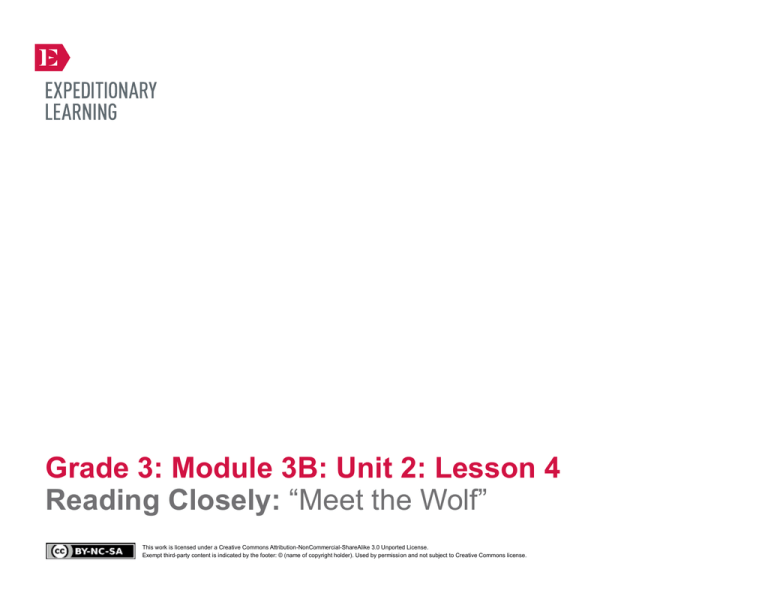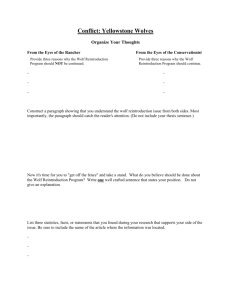
Grade 3: Module 3B: Unit 2: Lesson 4
Reading Closely: “Meet the Wolf”
This work is licensed under a Creative Commons Attribution-NonCommercial-ShareAlike 3.0 Unported License.
Exempt third-party content is indicated by the footer: © (name of copyright holder). Used by permission and not subject to Creative Commons license.
GRADE 3: MODULE 3B: UNIT 2: LESSON 4
Reading Closely:
“Meet the Wolf”
Long-Term Targets Addressed (Based on NYSP12 ELA CCLS)
I can answer questions using specific details from informational text. (RI.3.1)
I can determine the meaning of unknown words in informational text. (RI.3.4)
I can write informative/explanatory texts that convey ideas and information clearly. (W.3.2)
Supporting Learning Targets
Ongoing Assessment
• I can identify specific facts and details about the appearance and behaviors of wolves from Face to Face
with Wolves.
• Answers to Text-Dependent Questions: “Meet the Wolf”
(continued from Lesson 3)
• I can actively listen and share in discussions with my peers.
• Paragraph Writing Accordion graphic organizer
• I can find the meanings of unfamiliar words to help me better understand Face to Face with Wolves.
• Participation in adding to the Who Is the Wolf in Fact
anchor chart
• I can plan an informative paragraph about wolves using details from Face to Face with Wolves.
Copyright © 2013 by Expeditionary Learning, New York, NY. All Rights Reserved.
NYS Common Core ELA Curriculum • G3:M3B:U2:L4 • June 2014 • 1
GRADE 3: MODULE 3B: UNIT 2: LESSON 4
Reading Closely:
“Meet the Wolf”
Agenda
Teaching Notes
1. Opening
• In this lesson, students continue closely reading the second section, “Meet the Wolf.” As noted in
Lessons 1-3, the Text-Dependent Questions: “Meet the Wolf” are meant to be discussion-based.
A. Engaging the Reader and Unpacking Learning
Targets (5 minutes)
2. Work Time
A. Reading Closely: “Meet the Wolf” (35 minutes)
B. Guided Practice: Planning an Informational
Paragraph (10 minutes)
3. Closing and Assessment
A. Share and Debrief: Adding to the Who Is the Wolf in
Fact Anchor Chart (10 minutes)
4. Homework
A. Use the Paragraph Writing Accordion graphic
organizer completed in class to write a draft of an
informational paragraph in response to the focus
question for “Meet the Wolf.”
• As noted in Lesson 3, depending on the needs of your class, you may split this close reading into three
lessons instead of two.
• The end goal of Lessons 3 and 4 is for students to be able to answer the focus question posed in Lesson
3, “What does the author mean when he says that ‘wolves are social animals’? Explain what wolves do
that make them social animals.” Students are given the opportunity to do so in this lesson.
• In the second part of this lesson, students plan an informational paragraph responding to the focus
question posed in Lesson 3. This graphic organizer was also used in Module 2A. Students use the
Paragraph Writing Accordion anchor chart and graphic organizer to plan their writing in this unit.
Students will share this paragraph during the Opening of Lesson 5.
• A completed Who Is the Wolf in Fact anchor chart was included in the supporting materials of Lesson 2
for teacher reference. Refer to this throughout the unit as a guide for information to include on the
anchor chart.
• In advance:
– Review: Back-to-Back, Face-to-Face protocol (see Appendix)..
– Prepare: Paragraph Writing Accordion anchor chart.
– Post: Learning targets; Close Readers Do These Things anchor chart; Informational Text anchor
chart; Paragraph Writing Accordion anchor chart; Who Is the Wolf in Fact anchor chart.
Copyright © 2013 by Expeditionary Learning, New York, NY. All Rights Reserved.
NYS Common Core ELA Curriculum • G3:M3B:U2:L4 • June 2014 • 2
GRADE 3: MODULE 3B: UNIT 2: LESSON 4
Reading Closely:
“Meet the Wolf”
Lesson Vocabulary
Materials
synthesize, informational paragraph,
topic, detail; pack (10), territory (11),
social (13), communicate
• Face to Face with Wolves (book; one per student and one to display)
• Text-Dependent Questions: “Meet the Wolf” (from Lesson 3; one per student and one to display)
• Close Readers Do These Things anchor chart (from Module 1, Unit 1, Lesson 2)
• Close Reading Guide: “Meet the Wolf” (from Lesson 3; for teacher reference)
• Informational Text anchor chart (begun in Lesson 1)
• Paragraph Writing Accordion anchor chart (begun in Module 2A, Unit 1, Lesson 10; also included in supporting materials
for ease of reference)
• Paragraph Writing Accordion graphic organizer (one per student and one to display)
• Paragraph Writing Accordion graphic organizer: “Meet the Wolf” (answers, for teacher reference)
• Who Is the Wolf in Fact anchor chart (begun in Lesson 2)
Copyright © 2013 by Expeditionary Learning, New York, NY. All Rights Reserved.
NYS Common Core ELA Curriculum • G3:M3B:U2:L4 • June 2014 • 3
GRADE 3: MODULE 3B: UNIT 2: LESSON 4
Reading Closely:
“Meet the Wolf”
Opening
Meeting Students’ Needs
A. Engaging the Reader and Unpacking Learning Targets (5 minutes)
• Ask students to take out the fluency self-assessments they completed for homework.
• Discussing and clarifying the
language of learning targets helps
build academic vocabulary.
• Explain (or review) Back-to-Back, Face-to-Face protocol.
• Then, ask students to quickly find a partner.
• Invite students to turn back-to-back and review their self-assessments to identify the criteria they are focused on practicing.
After 30 seconds, ask students to turn face-to-face to share their thinking with their partners.
• After 2 minutes, invite a few students to share out their fluency goals and explain why they chose the goal. Answers will vary,
but listen for students to name specific criteria from the fluency self-assessment and explain specifically why they chose to
focus on that criteria after rereading “Meet the Wolf” aloud for homework.
• Focus students’ attention on the learning targets and ask them to chorally read each one aloud:
* “I can identify specific facts and details about the appearance and behaviors of wolves from Face to Face with Wolves.”
* “I can actively listen and share in discussions with my peers.”
* “I can find the meanings of unfamiliar words to help me better understand Face to Face with Wolves.”
* “I can plan an informative paragraph about wolves using details from Face to Face with Wolves.”
• Using the Back-to-Back, Face-to-Face protocol, invite students to share with a partner what each target means in their own
words.
• After each round of Back-to-Back and Face-to-Face, refocus students’ attention whole class and cold call one or two
partnerships to share their responses. Continue this process of Back-to-Back, Face-to-Face, and discussing whole class for
each target. Clarify any misconceptions students may have about key terms or the targets as necessary.
Copyright © 2013 by Expeditionary Learning, New York, NY. All Rights Reserved.
NYS Common Core ELA Curriculum • G3:M3B:U2:L4 • June 2014 • 4
GRADE 3: MODULE 3B: UNIT 2: LESSON 4
Reading Closely:
“Meet the Wolf”
Meeting Students’ Needs
Work Time
A. Reading Closely: “Meet the Wolf” (35 minutes)
• Remind students that they have been reading the second section of Face to Face with Wolves, “Meet the Wolf,” closely.
Invite students to take out their copy of the book and the Text-Dependent Questions: “Meet the Wolf” and remind
them that they are discussing questions about the text and using the form to record their thinking.
• Cold call a student to read the focus question at the top of the sheet:
* “What does the author mean when he says that ‘wolves are social animals’? Explain what wolves do that make them social
animals.”
• Remind students that they should keep this question in mind while reading this section.
• Direct students’ attention to the posted Close Readers Do These Things anchor chart and quickly review if necessary.
Tell students that the text they will read is challenging and may have unfamiliar words. Reassure them that just like when
they read folktales in Unit 1, they are not expected to understand it fully the first time. Remind them that one key to being a
strong reader of difficult text is being willing to not give up easily, and that they can do this by rereading and persevering
through difficult parts of the text.
• Display and invite students to turn to page 9 in Face to Face with Wolves.
• Review by asking:
* “Overall, what is this section about?”
• Listen for students to say something similar to: “This section explains how wolves live and interact with each other.”
• Remind students that close readers reread the texts they are analyzing paragraph-by-paragraph and sentence-by-sentence.
Explain to students that they will now continue to reread this section closely to think carefully about the focus question:
* “What does the author mean when he says that ‘wolves are social animals’? Explain what wolves do that make them social
animals.”
• Tell students they will be doing this by rereading paragraphs, sometimes on their own and sometimes with a partner, and
discussing the text as they read. Starting with Row 3 of the Close Reading Guide: “Meet the Wolf,” guide students
through rereading the text, inviting them to Think-Pair-Share and discuss the prompts as necessary. Be sure to lead the class
through the activities in the Close Reading Guide by following the notes in the right-hand column. Discuss and monitor
student responses to each question, and model strategies for navigating complex sections of the text as needed.
Copyright © 2013 by Expeditionary Learning, New York, NY. All Rights Reserved.
NYS Common Core ELA Curriculum • G3:M3B:U2:L4 • June 2014 • 5
GRADE 3: MODULE 3B: UNIT 2: LESSON 4
Reading Closely:
“Meet the Wolf”
Meeting Students’ Needs
Work Time (continued)
B. Guided Practice: Planning an Informational Paragraph (10 minutes)
• Explain to students that they will now synthesize what they have learned about wolves and plan an informational
paragraph responding to the focus question for this section:
* “What does the author mean when he says that ‘wolves are social animals’? Explain what wolves do that makes them
social animals.”
• Remind students that great writers do not just start writing. Writers make sure they have good information about their topic.
Ask:
* “What will be the topic of our paragraph?” Listen for students referring back to the focus question and saying something
like: “We will be explaining how wolves are social animals.”
• Explain to students that in doing the close reading of this section, they gathered information about wolves and that now they
need to plan and organize that information before they start writing.
• Explain that the paragraphs they will be writing are informational paragraphs.
• Direct students’ attention to the Informational Text anchor chart and review characteristics of informational texts.
• Ask:
* “What features should our paragraphs have if they are informational paragraphs?” Listen for responses like: “They should
have a clear main idea and details that support the main idea”; “The topic should be developed with facts, definitions, and
details from what we have read about wolves”; or “They ‘wrap up’ with a concluding statement.”
• Display the Paragraph Writing Accordion anchor chart.
• Ask students to remind themselves how to use this graphic organizer. If necessary, prompt students by asking questions like:
“What information do we put in this part of the organizer?”
• Ask:
* “How can this graphic organizer help you as a writer?” Listen for responses like: “It can help me make sure I think about
details that support my topic”; or “It can help me remember to include a sentence that states my topic, detail sentences,
and a concluding statement that sums up my paragraph.”
• Distribute a blank Paragraph Writing Accordion graphic organizer to each student.
• Using the Paragraph Writing Accordion graphic organizer: “Meet the Wolf” (answers, for teacher
reference), model filling in the Topic box, being sure to restate the focus question.
Copyright © 2013 by Expeditionary Learning, New York, NY. All Rights Reserved.
NYS Common Core ELA Curriculum • G3:M3B:U2:L4 • June 2014 • 6
GRADE 3: MODULE 3B: UNIT 2: LESSON 4
Reading Closely:
“Meet the Wolf”
Meeting Students’ Needs
Work Time (continued)
• Then lead the class in completing the first set of Detail and Explanation boxes together (see answers, for teacher reference
for possible responses).
• Invite students to work with a partner to complete the remaining Detail and Explanation boxes of the graphic organizer.
• After about 5 minutes, refocus students whole group. Cold call students to share their responses whole class.
• Lead the class in completing the last box, writing a concluding statement for the paragraph (see answers, for teacher
reference for a possible response).
• Explain to students that for homework, they will be using this graphic organizer to write an informational paragraph. Tell
students that they will share their paragraphs in Lesson 5.
Meeting Students’ Needs
Closing and Assessment
A. Share and Debrief: Adding to the Who Is the Wolf in Fact Anchor Chart (10 minutes)
• Redirect students’ attention to the posted Who Is the Wolf in Fact anchor chart.
• Tell students that, just as they did in Lesson 2, they will be adding facts and descriptions of wolves to this anchor chart that
they can include in the stories they will write in Unit 3.
• Ask students to discuss with a partner how they would describe the wolf in fact so far. Remind students to share what
evidence from the text makes them think so.
• After 1 or 2 minutes, invite a few students to share their thinking aloud. Listen for:
– “Wolves live in families called packs”;
– “The alpha male and female are the leaders of the pack”; and other ideas.
• Record students’ thinking in the appropriate sections on the Who Is the Wolf in Fact anchor chart, modeling how to record
the page number from the book. Remind students they will continue to revisit this chart as they read more of this text, which
will support their ability to answer the guiding questions and work they will do later in the module.
Meeting Students’ Needs
Homework
• Use the Paragraph Writing Accordion graphic organizer completed in class to write a draft of an informational paragraph in
response to the focus question for “Meet the Wolf.”
Copyright © 2013 by Expeditionary Learning, New York, NY. All Rights Reserved.
NYS Common Core ELA Curriculum • G3:M3B:U2:L4 • June 2014 • 7
Grade 3: Module 3B: Unit 2: Lesson 4
Supporting Materials
This work is licensed under a Creative Commons Attribution-NonCommercial-ShareAlike 3.0 Unported License.
Exempt third-party content is indicated by the footer: © (name of copyright holder). Used by permission and not subject to Creative Commons license.
GRADE 3: MODULE 3B: UNIT 2: LESSON 4
Paragraph Writing Accordion Anchor Chart
For Teacher Reference
Teacher Directions: Write the following on chart paper to create this anchor chart.
Topic:
Detail:
Explain:
Detail:
Explain:
Conclusion:
Copyright © 2013 by Expeditionary Learning, New York, NY. All Rights Reserved.
NYS Common Core ELA Curriculum • G3:M3B:U2:L4 • June 2014 • 9
GRADE 3: MODULE 3B: UNIT 2: LESSON 4
Paragraph Writing Accordion Graphic Organizer
Name:
Date:
Topic:
Detail:
Explain:
Detail:
Copyright © 2013 by Expeditionary Learning, New York, NY. All Rights Reserved.
NYS Common Core ELA Curriculum • G3:M3B:U2:L4 • June 2014 • 10
GRADE 3: MODULE 3B: UNIT 2: LESSON 4
Paragraph Writing Accordion Graphic Organizer
Explain:
Conclusion:
Copyright © 2013 by Expeditionary Learning, New York, NY. All Rights Reserved.
NYS Common Core ELA Curriculum • G3:M3B:U2:L4 • June 2014 • 11
GRADE 3: MODULE 3B: UNIT 2: LESSON 4
Paragraph Writing Accordion Graphic Organizer: “Meet the Wolf”
Answers For Teacher Reference
Name:
Date:
Topic:
Wolves are social animals.
Detail:
They live and work together with other wolves.
Explain:
ive in a pack
lpha pair (male and female) and offspring
Detail:
They communicate with each other.
Explain:
hare ideas and messages
se smells, growling, howling, and body language to communicate
Conclusion:
These are a few things wolves do that make them social.
Copyright © 2013 by Expeditionary Learning, New York, NY. All Rights Reserved.
NYS Common Core ELA Curriculum • G3:M3B:U2:L4 • June 2014 • 12
GRADE 3: MODULE 3B: UNIT 2: LESSON 4
Copyright © 2013 by Expeditionary Learning, New York, NY. All Rights Reserved.
NYS Common Core ELA Curriculum • G3:M3B:U2:L4 • June 2014 • 13





